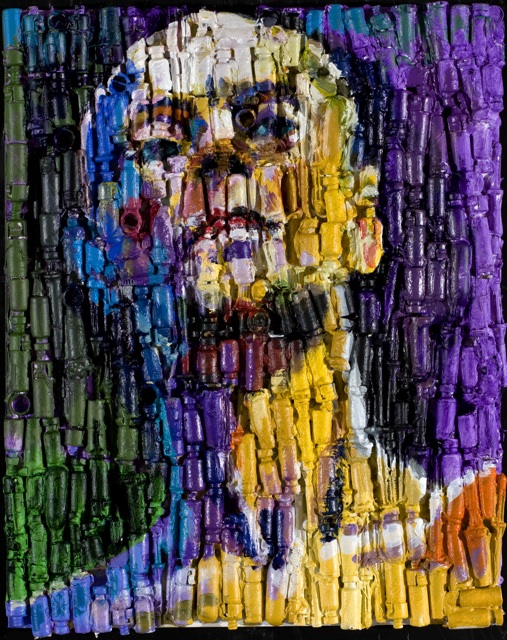Tiko Kerr Feature
Tiko Kerr is a renowned Canadian painter whose beautiful work is often rooted in the Pacific Northwest. He is well-known for his deep commitment to philanthropy and his active role in championing social causes.
Tiko has maintained a successful career as an artist entrepreneur. We are delighted to have him featured here in an e101 interview.
Application
1. As you read through Tiko’s interview, write down 6 points he makes that strike you as particularly relevant to your own entrepreneurial life as an artist. Why these particular points?
2. What key lessons can you take forward from Tiko’s insights as you map out your own future as an artist entrepreneur?
Interview Questions
1. At what point in your life and how did you make the decision that you were going to become a full-time artist?
I was raised as a single child in a rich and encouraging home environment.
I played piano from an early age so I was familiar with discipline and ways to express myself artistically.
My mother as it turned out was a teacher who taught at my elementary school.
I honestly attribute my first artistic expressions to the many hours I freely explored the medium of chalk on blackboard while waiting for my mother to finish her work. This was the beginning of a lifelong fascination with drawing and mark making and thinking about the act of seeing.
However I was also very much attracted to science and the physical world and decided early on to study to become a doctor.
After getting my undergrad degree in Biology I took some time off to go backpacking. I travelled to the farthest corners of the world alone for 6 years.
During that time I catalogued my experiences by drawing and painting in sketchbooks which over time, began to occupy substantial floor-space in my parents’ home.
This work had a profound effect on the work I would be creating afterward.
Travelling alone allowed me to develop a particularly indomitable sense of myself and it was then that I began to identify myself as an artist.
So in the early 1980’s I returned to Canada, dismissed the notion of gong to medical school, decided that Vancouver would be my home and rented a Spartan studio space on Railway Street, taking the exploration of the formal qualities of painting very seriously.
I had no formal artistic training and am an autodidact.
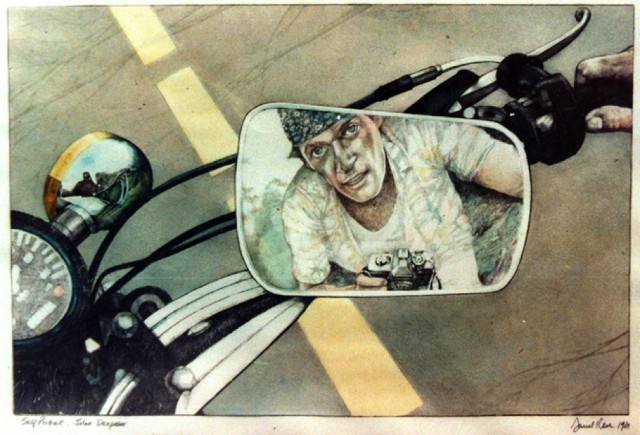
“Self Portrait: Jalan Denpasar” Graphite and Watercolour on Paper 22.5” X 30” 1981
2. Did you have any doubts about pursuing art full-time when you started and how did you overcome them?
Having doubts about one’s chosen path are constant and natural in most burgeoning careers.
In my case the mental career path shift from being a physician to becoming an artist was profound. Fortunately I was encouraged by my family.
I was very lucky in that I had a partner who fully believed in my success so that he worked many jobs in order to enable me to concentrate on my work.
My personal feeling is that having someone supportive in your life is essential to the economic and spiritual growth of any creative person.
I could not be where I am without my partner’s encouragement and support.
The chief reason I continued painting was that from time to time I would somehow manage to create a work of art that transcended the norm. This gave me hope that there was much more to be unearthed in my development.
I have become familiar with striving to find that place of authentic creativity.
In this situation I work silently, without an internal dialogue in my mind, working confidently, being fully engaged without distractions and exhilarated, watching almost as an observer, the magical movements my hand somehow knows how to make.
This is what still keeps me painting.
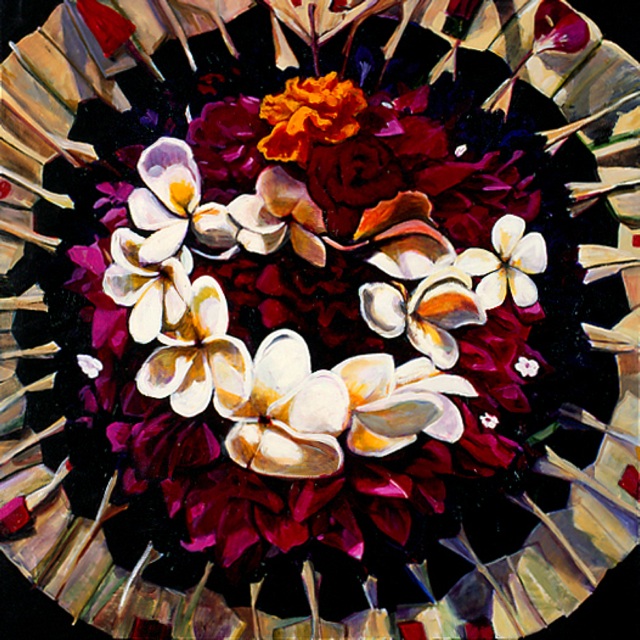
“Muse #9 (Victoria)” Acrylic on Canvas 48” X 48” 1993
3. How were you able to get out there and earn enough money to survive at the start?
In addition to having my partner bear the brunt of our financial responsibilities, I waited on tables evenings and painted during the day.
I showed work as much as I could and began to sell from time to time.
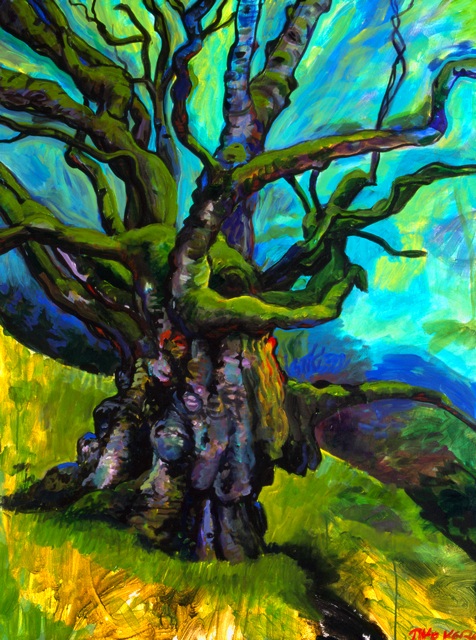
“The Great Elm, Skedans” Acrylic on Canvas 48” X 36” 2002
4. Early on, did you have any artist mentors or role models who helped or inspired you around earning a living doing the thing that you loved?
I’ve had the opportunity to study art in the greatest galleries in the world, so that I was able to develop an understanding of the history of art in order to create a visual library in my head that I could always call upon for reference.
Basically I put and continue to put exhaustive energy into learning the language of painting in order to improve my own fluency.
Therefore all artists whose work has intrigued me have had their influences.
Some artists inspire me for their output, others for their courage, others for the soul their work possesses, and others for their elevated understanding of the formal qualities of painting such as composition, colour, form etc.
Personally however I had the great fortune to be mentored by Jack Shadbolt during his life and afterward I developed a deep and profound friendship with his wife Doris Shadbolt whose wisdom still nourishes me.
After Jack’s death Doris offered me the opportunity to work in Jack’s studio on Hornby Island, as he had left it and the work I created during that period not surprisingly possesses that transcendence which I have described.
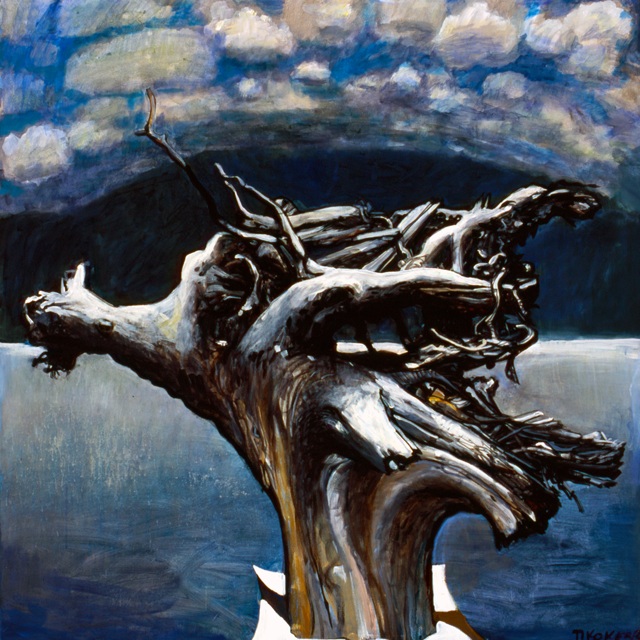
“ Reverential Stump (Blue)” Acrylic on Canvas 48” X 48” 2000
5. When did you start thinking about the business side of art – managing your accounts, taxes, selling, profile? How did that affect you and what you do?
After I began creating a substantial amount of work I was given good advice to find myself an accountant and a lawyer familiar with artists that were in business. For example I incorporated my business early on and the year the sales of my artwork reached $30,000.00 I registered my business for federal and provincial taxation.
Once I had amassed a substantial amount of paintings, I began shopping for gallery representation. One day in 1989 I walked into Buschlen Mowatt Gallery and somehow convinced them to take me on.
So began the first of many fruitful relationships with galleries that represented and promoted me, which customarily insisted on exclusively handling my work at least in the city of Vancouver and would take 50% commission on all sales.
I maintained my profile by having solo exhibitions annually and group shows from time to time, and by participating in fundraising events for various charities that interested me.
This not only gives me an opportunity to support organizations in a very real way, but allows me to escape the solitude of my work space and to know and be a part of the creative community. This is how I came to know artists such as Jack Shadbolt, Tony Onley and Gordon Smith who demonstrated strong work ethic, prolific output as well as their generosity to enhancing our world through art-making.
All these experiences allowed me to see myself as a serious artist and gave me the opportunity to develop my own generosity which I believe is an essential quality to being a successful artist.
Artists have 2 roles, we create work and we share it.
I give birth to my pieces and then send them out into the world to have their own lives. Hoarding one’s own work does not enhance anyone.
In time as other issues came into play in my life, I learned that my role as an active participant in Vancouver’s cultural community enabled me to use my profile and work to facilitate social causes.
Therefore I describe myself as an activist as well as an artist.

“Log at Water’s Edge” Acrylic on Canvas Diptych: 36” X 48” + 36” X 36” 1989
6. What role do galleries and other ‘intermediaries’ play in your life as a professional artist?
Some artists work well with gallery representation, some do not.
Vancouver has a huge creative community that far out numbers galleries to represent them.
I have had successful and some less successful experiences with galleries representing me. Through them all however I have learned more about the business of making and selling art.
The best galleries for me are the ones who give me the greatest freedom and encouragement and are the ones who are committed to paying me in a timely fashion.
Sometimes unfortunately there has been drama.
I insist on demonstrating and dealing only with proper professional conduct.
I have worked with art consultants whose commission is usually 20% and I have had my work auctioned by major auction houses (who’s commission is 10%) in order to get a feel for the value of my work in the larger market.
I am commissioned to create specific works by clients and again only take on these opportunities if I am given complete freedom.
Under these conditions I’m not required to pay any commission on sales to anyone else.
All sales are the market price of the piece plus 12% gst and pst sales tax. I submit my tax returns quarterly.
The development of the internet has enabled more clients to reach me directly.

“The Lazarus Tree” Acrylic on Canvas 96” X 72” 2008
7. What are some of the things that have surprised you about being an artist entrepreneur?
Initially I was surprised that I needed to have a very stringent work schedule. It’s easy to waste time when you’re self-employed.
Now I paint 6 days a week from 10 am to 4pm.
When I’m preparing for an exhibition I work day and night.
Being so consumed by my work in these circumstances taxes my energy but by far is the most thrilling and enjoyable times for me to be so focused in my studio.
Initially I painted in my home but I learned that I needed the separation of home and studio so I wouldn’t be distracted. Plus I found that by working at home, I found myself finessing my work well into the night and the outcome was over-working my paintings.
Learning how and when to stop creating a painting will always be an issue.
I firmly believe that a painting is never really finished.
One can easily get distracted by financial pressures and therefore sometimes
the stress can cause the work to be less authentic.
Therefore on some days I plan to make work that has a history of being successful in the market but that I am fully engaged in and on other days work that is completely my own. The method I use is that I plan to make work that no one else will ever see.
This liberates me.
I’ve learned you need to be reliable in showing up and making deadlines, in being professional in all communications and learning how to describe what I do. In addition I’ve learned to know how to handle myself with print, on- camera media, and with public speaking.
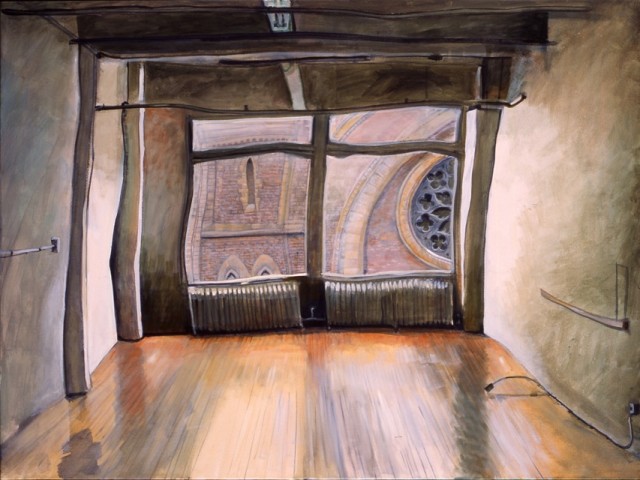
“ A Vague Suggestion of Religion” Acrylic on Canvas 36” X 48” 2005
8. What are some of the greatest challenges in being an artist entrepreneur?
As I have described, one of the chief challenges is acknowledging that I need to sell work and I also need my work to grow and explore new territory.
And all artists develop their own strategies on how to make these issues balance.
In addition to working to become commercially successful in galleries, another method of developing your career is by applying to the enormous number of grants that are easily discovered online as well as by getting to know artist-run centers, and showing in them.
Exhibiting your work in a non-commercial context can enable an artist’s career to develop without the shadow of commercialism upon it.
I think it is easier in this process for work be to considered less pandering to public taste and it is primary through this system that an artist work is embraced by public institutions such as museums.
The down side is that the financial challenges to such artists can be immense.
However by participating in the community and getting to know gallery directors, critics and curators, artists who have also enjoyed commercial success can still be noticed and can rise into the realm of public galleries and museums.
Deciding on which course best suits an artist early on is imperative.

“The Stones That Jack Held” 24” X 96” 2001
9. What are some of the most important pieces of advice you would give to young creators – of all stripes – who want to go into business for themselves?
Do everything you can to be consumed by your work. You need to be a creative person all the time in your life in and every way.
You need to make a lot of work.
Being an artistic entrepreneur is not a job.
It’s a method, which requires enormous dedication, by which a creative person can live on the proceeds of the work he or she creates.
It is a life spent doing what you love to do which is a very rare and wonderful experience.
It is a life you will do until the day you die but I believe you will never be more engaged or satisfied.
It’s a life that allows you the luxury of living within yourself, examining your own particular issues and concerns and giving you the opportunity to realize in a very physical way how you see the world.
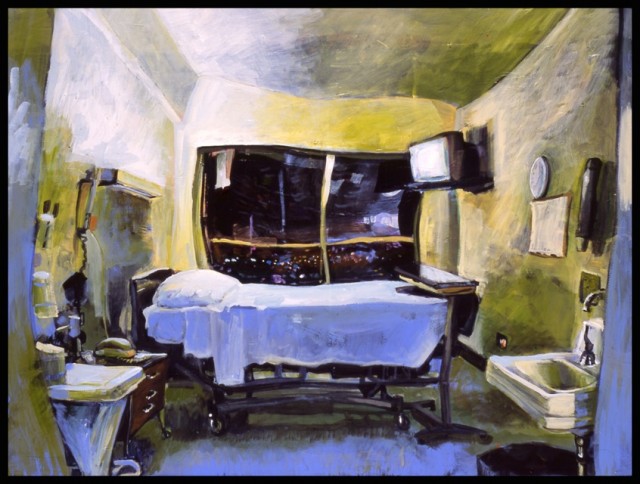
Meditations on Compassion” Acrylic on Canvas 36” X 48” 2006
10. Anything else that you would add?
I’ve always believed fundamentally that an artist’s responsibility is to describe somehow, honestly, the times in which he or she lives.
Documentation of inventory and financial transactions is imperative.
Photograph everything you make and discover the benefits of social media such as Twitter and Instagram in order to share the progress and presence of your work.
When presented with a business contract, read it meticulously, engage legal advice if you’re confused and if you have issues, have the contract rewritten to your specifications for both parties to endorse.
Above all, work to remain humble about yourself and your work.
But confident in your execution.
It’s an incredible privilege to be able to go into your studio every day and just create.
Very few people are given such freedom and encouragement.
An artist’s job is to enhance the lives of those around us.
Treat this as an imperative responsibility.
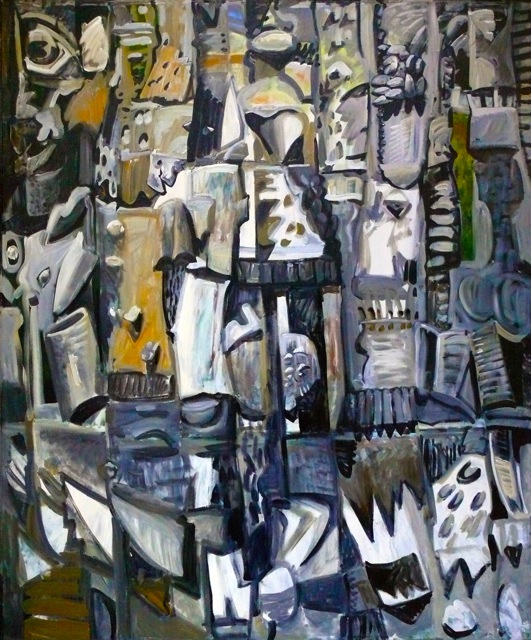
“Harlequin” Acrylic on Canvas 74” X 62” 2012

